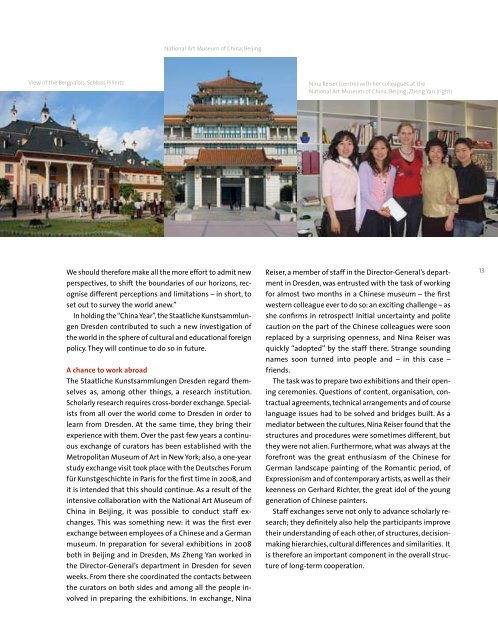2008 - Staatliche Kunstsammlungen Dresden
2008 - Staatliche Kunstsammlungen Dresden
2008 - Staatliche Kunstsammlungen Dresden
Create successful ePaper yourself
Turn your PDF publications into a flip-book with our unique Google optimized e-Paper software.
National Art Museum of China, Beijing<br />
View of the Bergpalais, Schloss Pillnitz Nina Reiser (centre) with her colleagues at the<br />
National Art Museum of China, Beijing, Zheng Yan (right)<br />
We should therefore make all the more effort to admit new<br />
perspectives, to shift the boundaries of our horizons, recognise<br />
different perceptions and limitations – in short, to<br />
set out to survey the world anew.”<br />
In holding the “China Year”, the <strong>Staatliche</strong> <strong>Kunstsammlungen</strong><br />
<strong>Dresden</strong> contributed to such a new investigation of<br />
the world in the sphere of cultural and educational foreign<br />
policy. They will continue to do so in future.<br />
A chance to work abroad<br />
The <strong>Staatliche</strong> <strong>Kunstsammlungen</strong> <strong>Dresden</strong> regard themselves<br />
as, among other things, a research institution.<br />
Scholarly research requires cross-border exchange. Specialists<br />
from all over the world come to <strong>Dresden</strong> in order to<br />
learn from <strong>Dresden</strong>. At the same time, they bring their<br />
experience with them. Over the past few years a continuous<br />
exchange of curators has been established with the<br />
Metropolitan Museum of Art in New York; also, a one-year<br />
study exchange visit took place with the Deutsches Forum<br />
für Kunstgeschichte in Paris for the first time in <strong>2008</strong>, and<br />
it is intended that this should continue. As a result of the<br />
intensive collaboration with the National Art Museum of<br />
China in Beijing, it was possible to conduct staff exchanges.<br />
This was something new: it was the first ever<br />
exchange between employees of a Chinese and a German<br />
museum. In preparation for several exhibitions in <strong>2008</strong><br />
both in Beijing and in <strong>Dresden</strong>, Ms Zheng Yan worked in<br />
the Director-General’s department in <strong>Dresden</strong> for seven<br />
weeks. From there she coordinated the contacts between<br />
the curators on both sides and among all the people involved<br />
in preparing the exhibitions. In exchange, Nina<br />
Reiser, a member of staff in the Director-General’s department<br />
in <strong>Dresden</strong>, was entrusted with the task of working<br />
for almost two months in a Chinese museum – the first<br />
western colleague ever to do so: an exciting challenge – as<br />
she confirms in retrospect! Initial uncertainty and polite<br />
caution on the part of the Chinese colleagues were soon<br />
replaced by a surprising openness, and Nina Reiser was<br />
quickly “adopted” by the staff there. Strange sounding<br />
names soon turned into people and – in this case –<br />
friends.<br />
The task was to prepare two exhibitions and their opening<br />
ceremonies. Questions of content, organisation, contractual<br />
agreements, technical arrangements and of course<br />
language issues had to be solved and bridges built. As a<br />
mediator between the cultures, Nina Reiser found that the<br />
structures and procedures were sometimes different, but<br />
they were not alien. Furthermore, what was always at the<br />
forefront was the great enthusiasm of the Chinese for<br />
German landscape painting of the Romantic period, of<br />
Expressionism and of contemporary artists, as well as their<br />
keenness on Gerhard Richter, the great idol of the young<br />
generation of Chinese painters.<br />
Staff exchanges serve not only to advance scholarly research;<br />
they definitely also help the participants improve<br />
their understanding of each other, of structures, decisionmaking<br />
hierarchies, cultural differences and similarities. It<br />
is therefore an important component in the overall structure<br />
of long-term cooperation.<br />
13

















